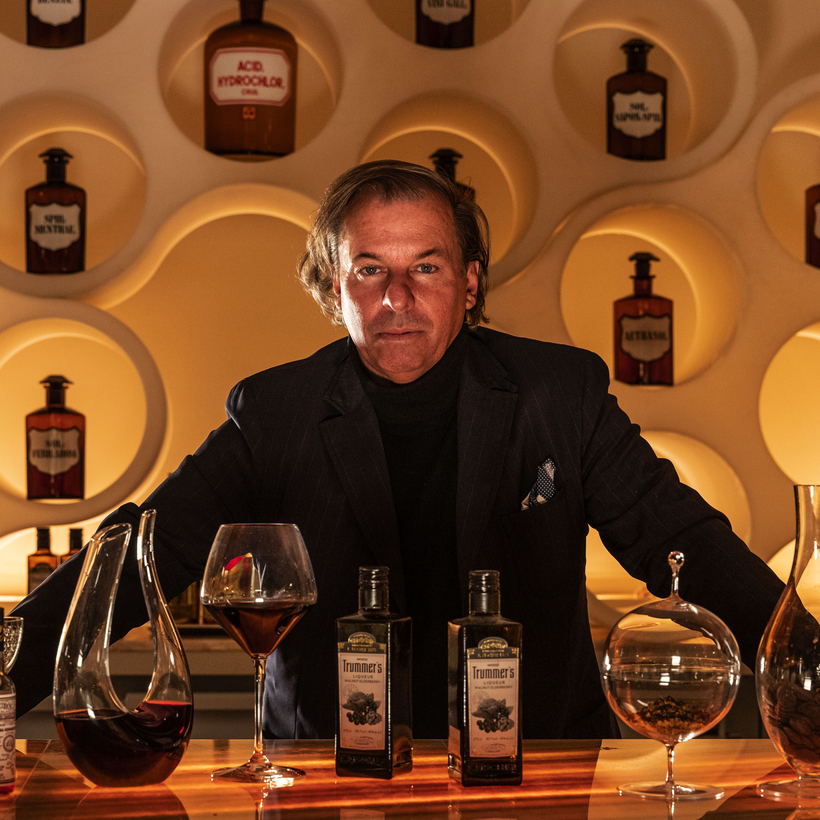Don’t expect a pyrotechnic display at Albert Trummer’s new cocktail bar. The Austrian bartender is best known for his run-ins with the New York City Fire Department at the apothecary-themed Chinatown speakeasy, Apotheke, where he used to douse the bar top in spirits and set them alight. Footage from The Real Housewives of New York City captured three-foot-high flames there in 2010.
After the episode aired, a raid by undercover fire marshals resulted in two days of community service for Trummer and the eventual shuttering of what had been, for a time, one of the hottest cocktail dens in New York. “They all thought I was a crazy maniac,” he says of the fallout. “It cost me a successful business.”
Trummer went on to launch some of the city’s most over-the-top, if short-lived, drinking establishments—from Theater Bar, with its bartending magician, to Bar Freud, with its cocktail “prescriptions,” to the hospital-themed Sanatorium, where the soothing green paint job was inspired by the set of One Flew Over the Cuckoo’s Nest.
Trummer has mellowed a bit in recent years. Dom (short for “domicile”), the New York comeback project off lower Park Avenue that he opened with his 27-year-old son, Jakob, last week, is a low-key lounge with a Rat Pack vibe. Though he plans to keep fireplay to a minimum, the landlord still wondered if he should get better fire insurance. “It’s not like I’m running around like an arsonist,” says Trummer.
The new bar, which is beneath the New York branch of British steak house Hawksmoor, will cultivate an early-evening crowd, with a focus on aperitifs—champagne cocktails and Negroni riffs—and bar snacks from chef (and fellow Austrian) Wolfgang Ban.

After a big steak upstairs, one might opt for the house-bottled digestif, Trummer’s Walnut Elderberry Liqueur, distilled in Vienna and soon to be sold at retail shops in New York. “Everybody is focusing on late night,” says Trummer. “We want to be the early speakeasy—come before dinner and after dinner.”
He hopes to evoke memories of the “old Stork Club and Copacabana” in the subterranean space, with plenty of room between tables and live piano or big-band music pumped through enormous speakers. “It’s almost a mini Lincoln Center,” he says of the setup.
Trummer worked with Italian art director Giulio Cappellini on the décor and brighter-than-usual lighting. “He said, ‘Albert, I’ll help you to design, but you need to make it bright and light. Do not make the place dark, like for the Kardashians,’” recalls Trummer of his meeting with Cappellini in Milan last year.
“They all thought I was a crazy maniac. It cost me a successful business.”
The cocktail creations—shaken and stirred here behind a 32-foot-long slab of glowing honey-colored onyx—blur the line between kitchen and bar, with plenty of fresh herbs and spices. Trummer grew up in a restaurant-owning family, attended culinary school, and adopted the title “bar chef.”
At Dom, the bartenders all wear lab coats, as they did at Apotheke, working from a drinks list arranged by therapeutic headings: “stress relievers,” “painkillers,” “euphoric enhancers.” Most signature cocktails feature Trummer’s own infusions and tinctures—“house remedies,” such as Chamomile Elixir and Saffron Essence—developed over the last 20 years.
Trummer, a born entertainer, plans to offer drinks tableside from roving carts and, for special occasions, to saber champagne magnums with Japanese swords. “The bar is always a performance,” he says. “Of course, we’re bringing a show aspect. Whatever we’re legally allowed.”
Along with collaborating with his father at Dom, Trummer’s son, Jakob, will launch his own bar, the RX Room—a sort of Apotheke 2.0—in New York’s financial district this summer. Jake began to apprentice behind the bar when he was just 14, learning early on to play with fiery drinks. While serving cocktails at Miami’s Shelborne South Beach hotel a few years back, he’d sometimes show off his fire-breathing skills while perched on the bar. “We don’t do that anymore,” he says. “No more flames. Maybe we’ll do an ice show instead.”
Jay Cheshes writes about art, culture, food, travel, and crime. He regularly contributes to The Wall Street Journal and WSJ. He trained as a chef at the Culinary Institute of America and has served as a restaurant critic for Gourmet and Time Out New York

